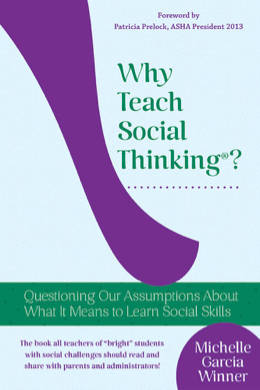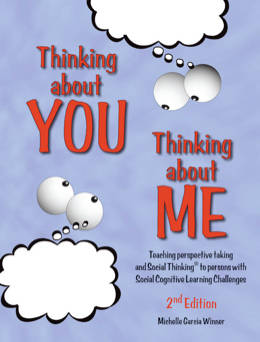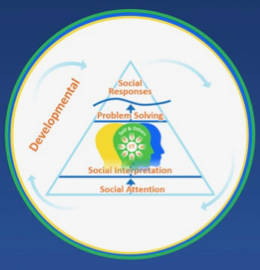Understanding how the social world works
The social world is an enormous and complex place. You, the interventionist, must first gain your own understanding of how the social world works before teaching social emotional learners about it. The Social Thinking Methodology relies on both evidence-based and evidence-informed information to teach social learners about the how the social world works. We also believe in the importance of taking time to understand the social learner from their unique perspective. We consider how the individual learns best, what they value, and their social goals. It is only after spending time understanding the social world and the social learner that we begin to tackle strategies for teaching how to work (navigate to regulate) in the social world. The Social Thinking Methodology has specific components to teach about these aspects through free articles, products, conferences, livestreams, on-demand courses, and free webinars.
Interventionists can explore the Social Thinking Methodology through these portals in this order:

Social landscapes in the social world
Whenever we co-exist around others (e.g., share physical space, interact) or interpret others’ words or actions (e.g., YouTube, movies, TV, sports, literature, working in groups, history, social studies, face-to-face interactions), we are a part of different social landscapes in the social world.
Each social landscape requires social attention, interpretation, problem solving, and responding based on the situation, the people, and context. Our social mind is the driver of this process. The Social Thinking-Social Competency Model (ST-SCM), based on the literature in social information processing, serves as the home base for making sense of the social world and guides our understanding and how we teach. Furthermore, it reinforces that the social mind is active in both social interactions and self-regulation within a group (e.g., classroom, restaurant, etc.). We use our social minds to understand and engage in academic curricula and related standards of education. We call this the social-academic connection.
How we use our social mind as a bridge to academics is explained in a variety of ways within our methodology, beginning with two conceptual frameworks: the ILAUGH Model of Social Cognition and the Social Thinking Social Learning Tree. These frameworks spotlight core socially based critical thinking tasks (e.g., academic connections to social competencies, group projects, professional team meetings, etc.) that are critical for engaging across social landscapes. The book, Why Teach Social Thinking?, provides an overview of how the social mind develops, the social-academic connection, and why it is important to use cognitive or metacognitive approaches for social learning. The social world requires our brain to engage synergistically using a range of core social functions, such as self-regulation and executive functioning (organizational and social), perspective taking (theory of mind), and central coherence, to name a few.
Practical ideas for teaching about the social world
The social world is all around us every time we are in the presence of others. When we're standing in line, we are expected to know what to do and not do. The same is true when we're having a conversation with others or simply sharing space. Figuring out how the social world works is much more than understanding direct person-to-person interactions. While most individuals, beginning in infancy, evolve in their understanding of how the social world works, those with social emotional learning challenges require direct explicit teaching.
The Social Thinking Methodology (STM) includes multiple teaching and support frameworks to explore key aspects of the social world through a practical lens. The core book, Thinking About YOU Thinking About ME, guides interventionists in building direct strategies and lessons from these frameworks. The methodology also includes 25+ unique Social Thinking Vocabulary terms and mini-lesson plans to teach about many aspects of the social world we largely take for granted. Some of our core vocabulary concepts have also been taught through free webinars.
Evidence-based and evidence-informed practices and the Social Thinking Methodology
The methodology includes components that are empirically supported, evidence-based, and evidence-informed. Our core reference article, "Research to Frameworks to Practice" gives a big-picture view of the evidence forming the foundation of the methodology. It shows the link between research to practice through conceptual frameworks, teaching frameworks, strategies, motivational/developmental tools, etc. Other resources for understanding the evidence supporting the methodology can be found in the evidence section of the website as well as this important peer-reviewed article.
Components of the STM also align with the five core elements of social emotional learning (SEL) that contribute to social competencies identified by the Collaborative for Academic, Social, and Emotional Learning (www.casel.org).
Different needs for different learners
Like any world, the social world is multi-layered and complex, not flat nor linear. Meeting the social learner “where they are” at any point in time allows us to consider their current social knowledge base to design supports to meet their social goals.
Different students within the same grade level (or age) will demonstrate different social emotional learning abilities across a broad spectrum of social cognition. The spectrum of social cognition also extends to those with significant social emotional learning differences and/or challenges to neurotypicals.
Different social minds – another way to understand social emotional learners
The STM includes assessment tools to explore how social learners understand and respond in the social world. There are two developmentally based scales to better define learning strengths and needs. The first is a tool for early learners (ages 4-7) called the Group Collaboration, Play and Problem Solving Scale (GPS). The second scale is for older individuals (ages 8+) called the Social Thinking-Social Communication Profile or the ST-Social Communication Characteristic Summary. Both tools help the interventionist understand social learning characteristics. This allows the interventionist to figure out where to begin in the support process.
Social Thinking Dynamic Assessment
The STM also provides ideas and tasks for engaging social emotional learners in specific social activities during dynamic face-to-face interactions as part of the assessment process. This information, which is almost always lacking in standardized testing, helps interventionists better understand social processing and responses in real-time social situations. The tasks in the dynamic assessment are designed for the interventionist to explore how efficiently social emotional learners process and respond to socially based information they are likely to encounter in their daily experiences in the social world. These qualitative assessment tasks make up the Social Thinking Dynamic Assessment Protocol found in Thinking About YOU Thinking About ME (Winner, 2007).
Supporting how one navigates to regulate in the social world
Many social emotional learners are described as “bright” if not “gifted”—yet they may struggle to understand how to navigate and/or regulate within the social world. Neurotypically developing as well as Neurodivergent children can benefit from very explicit social teaching. So, how do we make intangible social concepts teachable and learnable in a concrete and relatable way?
Our products, online training, conferences, and free webinars provide information that is developmentally based and created to be used with social emotional learners across and within different age groups. Our frameworks and teaching strategies go beyond simply using language to "explain"; they break down socially abstract information into more concrete elements via Social Thinking Vocabulary and support frameworks. Our materials actively engage social emotional learners through visual supports and teaching scaffolds and are designed to support learners in making progress toward one’s personal social goals.
Compassion as our guide
Interventionists tend to assume social emotional learners will figure out—mostly on their own—how to socially behave across an enormous range of social landscapes. When social emotional learners are young, behavior plans are commonly used to correct or direct social behaviors in lieu of teaching about how to self-regulate in the social world. The STM takes a different and more compassionate approach: the complexities of the social emotional world require further explanation and demonstration.
The STM helps to make connections: to interventionists, interventionists to learners, and learners to learners. We all engage in the social world and, at some point, we all struggle in social situations. The practical nature of our teaching and the concrete way we explain social concepts helps engage students in social emotional learning not only about themselves but about others.

Why Teach Social Thinking?
Why do some students with solid language and learning skills need explicit teaching about social concepts? This book details how the Social Thinking Methodology supports a child’s learning in a group, attending to important social information, and improving academic performance. It also tackles questions about how the Social Thinking Methodology integrates the latest research and differs from a purely behavioral or ABA skills-based approach. This unique resource drives home the importance of social learning to success academically, professionally, and across life.

Thinking About You Thinking About Me
Our informative and accessible bestseller is ground zero for understanding core components of the Social Thinking Methodology. It explores the social learning process and weaves together research with examples of how to teach social concepts. This foundational resource introduces core frameworks and related strategies and describes the Social Thinking Dynamic Assessment Protocol.

Social Thinking–Social Competency Model
Have you ever wondered how we participate in the social world? How do we know what to do or say in a given situation? The Social Thinking-Social Competency Model breaks down this big, complex process into four foundational steps for our students to learn, use, and build on throughout their lives. Explore the steps and let them inspire your teaching!











